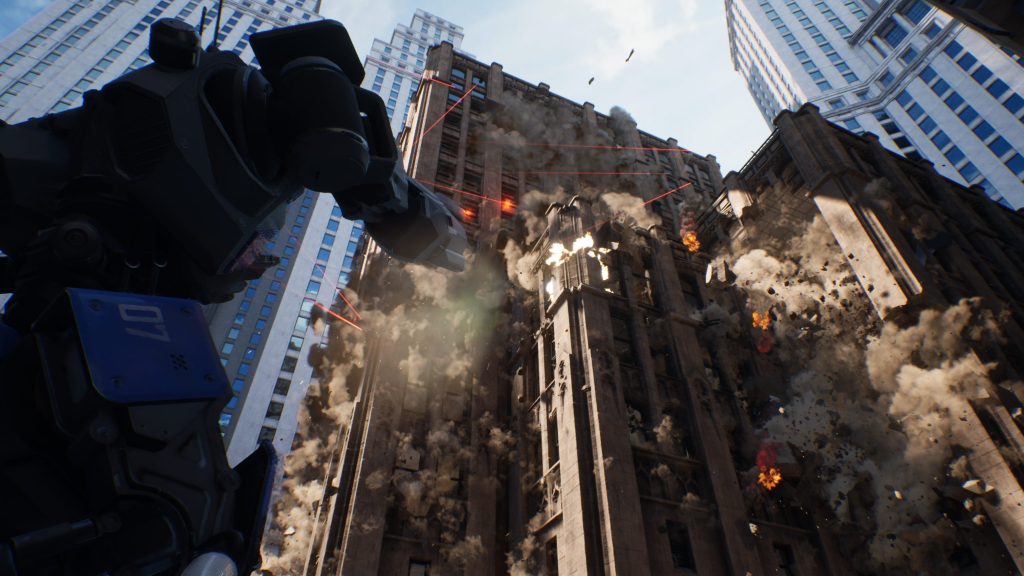Why Use Chaos Destruction System UE5 in Cinematics?
The Chaos Destruction System UE5 isn’t only for gameplay — it is also a powerful cinematic tool for real-time film sequences, cutscenes, previs, and virtual production. Instead of pre-rendered destruction (Maya / Houdini / offline sims), Chaos lets you:
✅ Simulate destruction live in UE5
✅ Trigger destruction in Sequencer with full camera control
✅ Sync debris, explosions, and collapse timing with animation and sound
✅ Preview final shots instantly — no offline simulation needed
✅ Render final imagery using Movie Render Queue at film quality
It gives filmmakers and previs teams the same destruction used in AAA games, but inside a director-friendly, timeline-based workflow.
Chaos Destruction for Cinematics vs Gameplay
| Feature | Gameplay Use | Cinematic Use |
|---|---|---|
| Triggering | Player actions | Sequencer events / keyframes |
| Performance priority | Real-time FPS | Visual quality |
| Physics behavior | Unpredictable / interactive | Fully directed / choreographed |
| Reproducibility | Variable outcomes | Exact same take every render |
| Final rendering | In-engine real-time | Movie Render Queue (cinema quality) |
Cinematics use Chaos in a more controlled and repeatable way — closer to VFX simulation than gameplay physics.
Core Workflow: How Chaos Fits Into Sequencer
Chaos destruction can be controlled entirely in Sequencer, Unreal’s cinematic timeline.
🎬 Common use cases in Sequencer:
| Cinematic Action | Chaos Feature |
|---|---|
| Wall explodes on cue | Chaos Field keyframed in Sequencer |
| Bridge collapses during camera move | Geometry Collection triggered at frame 90 |
| Debris follows explosion timing | Niagara FX linked to Chaos event |
| Slow-motion destruction shot | Time Dilation or slow-mo physics sim |
Sequencer lets you decide exactly when the object breaks, not just if it breaks.
Key Chaos Features Useful for Film Sequences
1. Geometry Collections for Breakable Props
Convert static meshes (walls, statues, columns, vehicles) into destructible assets with fracture layers.
✔ Outer shell + inner core for realism
✔ Control chunk size for close-up or wide shots
✔ Simulate only when destruction happens
2. Fracture Types for Film-Style Breaks
| Fracture Type | Cinematic Use |
|---|---|
| Radial fracture | Explosions, shockwaves |
| Cluster fracture | Shattering glass / pottery |
| Custom fracture | Hero props or controlled break lines |
| Multi-layer fracture | Concrete with rebar, drywall + dust core |
Custom fracture patterns = hero shots that match story beats.
3. Chaos Fields for Directed Explosions
Chaos Fields act like invisible VFX forces. In cinematics, they’re keyframed like animation.
Examples:
💥 Explosion at frame 72
💥 Shockwave pushes debris away from camera
💥 Gravity field collapses structure after delay
💥 Noise field adds secondary vibrations
Everything lands on exact frames, not random simulation timing.
4. Niagara Integration for Cinematic Debris + Dust
Chaos only handles physics — Niagara handles visual FX:
✔ Dust clouds rising in sunlight
✔ Pebbles and plaster debris
✔ Sparks, embers, smoke trails
✔ Fire + shockwave VFX
✔ Embers floating during slow motion
Chaos event → Niagara spawns → Movie Render Queue outputs final frame quality.
5. High-End Rendering with Movie Render Queue (MRQ)
To turn Chaos simulation into film-ready output:
🎥 Render using Movie Render Queue
✔ Motion blur
✔ Raytraced reflections
✔ Lumen GI
✔ Anti-aliasing & temporal super-resolution
✔ EXR sequence output ready for Nuke / Resolve
Real-time destruction → final frames look offline rendered.
Using Chaos for Virtual Production & LED Stages
Chaos is increasingly used in live filmmaking environments, including:
✅ Real-time previs (director sees the collapse live)
✅ Triggering destruction during motion-capture or Takes
✅ Live events on LED walls
✅ Stunt previs (real actors + digital destruction overlay)
✅ Mixed reality shots (practical set + VFX breakage)
Chaos + Lumen + MRQ = real-time VFX pipeline.
Best Practices for Cinematic-Quality Destruction
✔ Sim first, then cache → don’t recalc every render
✔ Increase fracture detail for “hero” objects only
✔ Use secondary debris + dust for realism
✔ Add camera shake, sound cues, and micro-motion
✔ Bake Chaos sim before hand-animating cameras
✔ Disable unnecessary collisions during render
✔ Always preview sims at final shot frame rate (24/30/60fps)
Suggested Images + Alt Text
| Image | Alt Text |
|---|---|
| UE5 Sequencer panel with Chaos keyframes | “Chaos Destruction triggered in Sequencer timeline” |
| Exploding wall with Niagara dust | “Cinematic explosion using Chaos and Niagara in Unreal Engine 5” |
| Bridge collapse wide shot | “Film-quality destruction rendered in Movie Render Queue” |
| Geometry Collection fracture view | “Fractured mesh prepared for Chaos simulation” |
FAQ: Chaos Destruction System for Cinematics
1. Can Chaos be used in non-game UE5 projects like films?
Yes — Chaos is fully usable for cutscenes, animated shorts, previs, and virtual production.
2. Does Chaos work in Sequencer?
Yes — destruction can be keyed, triggered, or simulated inside Sequencer.
3. Do I need Niagara for cinematic explosions?
Chaos = physics, Niagara = VFX. You typically use both together.
4. Can Chaos destruction be baked or cached?
Yes — caching is recommended for reliable rendering.
5. Is Chaos good enough for movie-quality VFX?
Yes — when rendered with Movie Render Queue and layered with Niagara.
6. Can I slow down Chaos destruction for slow-motion shots?
Yes — via physics substepping or Sequencer time dilation.
- Unreal Engine 5 Chaos Physics: Complete Guide to Real-Time Destruction & Simulation
- Quick Start for Niagara Effects in Unreal Engine

Leave a Reply